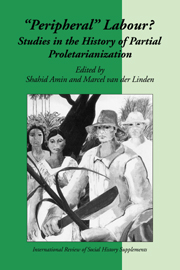Book contents
- Frontmatter
- Contents
- Introduction
- Colonialism, Capitalism and the Discourse of Freedom
- The Barriers to Proletarianization: Bolivian Mine Labour, 1826–1918
- Labour, Ecology and History in a Puerto Rican Plantation Region: “Classic” Rural Proletarians Revisited
- Coal and Colonialism: Production Relations in an Indian Coalfield, c. 1895–1947
- “Capital Spectacles in British Frames”: Capital, Empire and Indian Indentured Migration to the British Caribbean
- Unsettling the Household: Act VI (of 1901) and the Regulation of Women Migrants in Colonial Bengal
- Sordid Class, Dangerous Class? Observations on Parisian Ragpickers and their Cités During the Nineteenth Century
- Notes on Contributors
Introduction
Published online by Cambridge University Press: 14 October 2009
- Frontmatter
- Contents
- Introduction
- Colonialism, Capitalism and the Discourse of Freedom
- The Barriers to Proletarianization: Bolivian Mine Labour, 1826–1918
- Labour, Ecology and History in a Puerto Rican Plantation Region: “Classic” Rural Proletarians Revisited
- Coal and Colonialism: Production Relations in an Indian Coalfield, c. 1895–1947
- “Capital Spectacles in British Frames”: Capital, Empire and Indian Indentured Migration to the British Caribbean
- Unsettling the Household: Act VI (of 1901) and the Regulation of Women Migrants in Colonial Bengal
- Sordid Class, Dangerous Class? Observations on Parisian Ragpickers and their Cités During the Nineteenth Century
- Notes on Contributors
Summary
The proletarians have lost their innocence. A conservative sociologist once described wage labourers as follows:
The worker is personally free, i.e. his physical and spiritual-moral powers are completely at his own disposal. […] He has no property, i.e. he has no exclusive material power over capital as a secure basis with relative permanency. […] He has neither a stock of consumer goods that enable him to live, nor permanent interests of capital. […] He lives in economic circumstances in which means of subsistence can be obtained only through economic returns. […] He is forced to offer personal capacities with an economic exchange value in return for means of subsistence.
The fact that this description – disregarding its formulation – is almost identical to the classical Marxist definition indicates a broad consensus regarding the characteristics of proletarians among intellectuals in the first half of the twentieth century. Implicitly, proletarians were considered to be male, were perceived in isolation from their families or households, and were associated with a “pure” social category: while personally free and without property, they were compelled to sell their individual capacities or skills for money. These proletarians were viewed not as abstract theoretical constructs, but (at least in the advanced countries and in the societies of “really existing socialism”) as concrete living people whose number was increasing rapidly by any standard. While some historians and social scientists may have suspected that workers could also be females, might live in families or households that combined several “coping strategies”, and sometimes had their freedom severely restricted by debts or other impediments, etc., these insights did not play a significant theoretical role.
Information
- Type
- Chapter
- Information
- Peripheral LabourStudies in the History of Partial Proletarianization, pp. 1 - 8Publisher: Cambridge University PressPrint publication year: 1997
